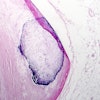Computer-aided detection (CAD) technology can improve radiologists' sensitivity for detecting solid lung nodules 4 mm or larger during multidetector CT chest screening studies, according to research published in the October issue of the American Journal of Roentgenology.
"In the context of temporal comparison of MDCT screening examinations, the sensitivity of radiologists for detecting lung nodules ≥ 4 mm increased significantly (p ≤ 0.025) with CAD input without compromising reading time," wrote a research team from Pitié-Salpêtrière Hospital in Paris and R2 Technology (now part of Hologic, Bedford, MA).
To assess the detection, tracking, and reading of these nodules using CAD, the researchers studied 54 pairs of low-dose MDCT chest examinations. The exams were collected from a population of 33 adults participating in the Depiscan French pilot screening study (AJR, October 2007, Vol. 189:3, pp. 948-955).
All CT studies were performed on a LightSpeed 16-slice CT scanner (GE Healthcare, Chalfont St. Giles, U.K.) with acquisition parameters of 100-120 kVp, 100-209 mA with a tube rotation of 700 msec, and pitch of 1.3. An effective slice thickness of 1.25 mm with a reconstruction interval of 0.6 mm was used, according to the study team. No contrast material was employed.
Two chest radiologists in consensus established that 25 exams contained 52 nodules 4 mm or larger. The paired exams were then interpreted on version 2.0 of the ImageChecker CT CAD workstation (Hologic) for detecting and tracking lung nodules, before and after CAD input. A subset of 33 examination pairs were later read on the clinical workstation used in daily practice, with the results compared with the CAD workstation to evaluate reading time.
The researchers found that after CAD input, nodule detection sensitivity was increased 9.6% for one reader and 23% for the other. CAD input also led to correct identification of one cancer that was initially missed by one radiologist.
Overall reading time was comparable for both radiologists on the CAD and clinical workstations. Readers averaged four to five minutes per case to read the paired examinations on the CAD workstation, and six to eight seconds per CAD mark, according to the researchers.
The CAD system successfully matched 91.3% of the nodules detected in both exams, and the overall rate of available CAD growth assessment was 54.9% of all nodule pairs.
The researchers acknowledged several limitations in their study, including the limiting of nodule definition to noncalcified solid nodules 4 mm or larger in size. In addition, the CAD software is not designed to detect ground-glass opacities; seven of the 33 patients had one ground-glass opacity greater than 4 mm that was not detected by the CAD system. Also, the database used in the study consisted of a limited number of temporal exams with a small number of nodules 4 mm or larger.
"But despite this limitation, the impact of CAD detection was statistically significant," the authors wrote.
The sensitivity of both observers for detecting solid nodules 4 mm or larger on MDCT chest examinations increased by 9.6% and 23% with CAD input, which was statistically significant (p = 0.025 and p = 0.0005, respectively).
"This increase in sensitivity was in the context of temporal comparison of current and prior low-dose MDCT examinations in a lung cancer screening program and occurred without compromising the reading time," the authors concluded. "Finally, the potential of CAD to assess more accurately the growth of indeterminate nodules may prove useful in allowing an earlier decision for intervention."
By Erik L. Ridley
AuntMinnie.com staff writer
September 21, 2007
Related Reading
Integrating PACS and MDCT: 10,000 slices and growing, September 3, 2007
Radiologists no match for nodule measurement software, August 31, 2007
SUV readings vary on different PET systems, study finds, July 25, 2007
Low-dose CT practical for lung cancer screening, April 30, 2007
Copyright © 2007 AuntMinnie.com





















